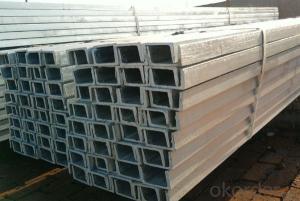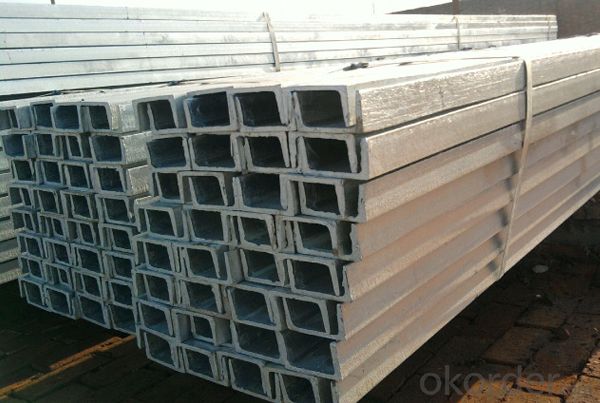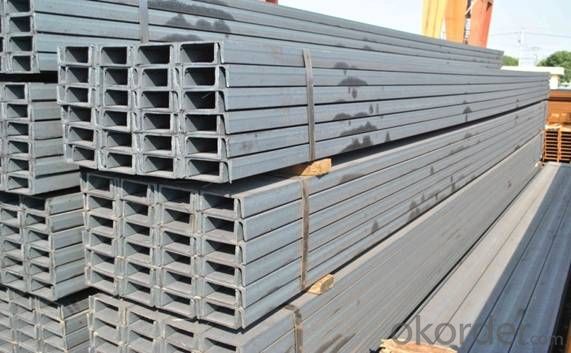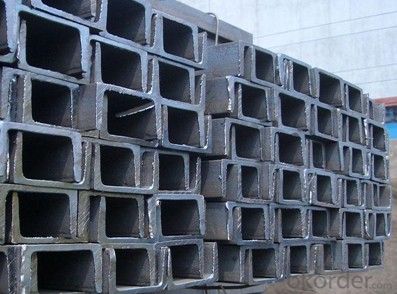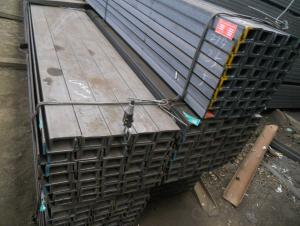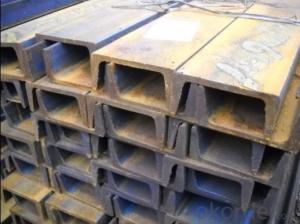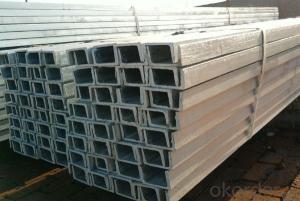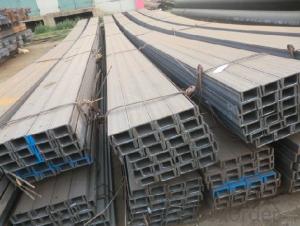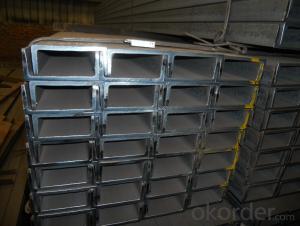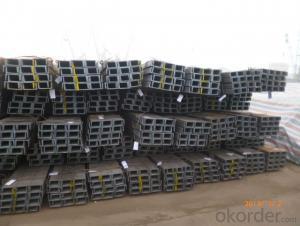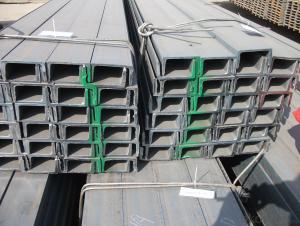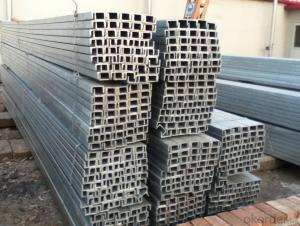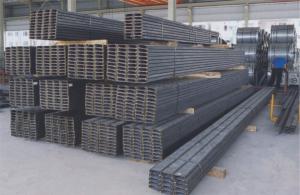U CHANNEL GB and JIS standard High Quality Hot Rolled
- Loading Port:
- Tianjin
- Payment Terms:
- TT or LC
- Min Order Qty:
- 25 m.t.
- Supply Capability:
- 20000000 m.t./month
OKorder Service Pledge
OKorder Financial Service
You Might Also Like
Product Description:
OKorder is offering high quality Hot Rolled Steel I-Beams at great prices with worldwide shipping. Our supplier is a world-class manufacturer of steel, with our products utilized the world over. OKorder annually supplies products to European, North American and Asian markets. We provide quotations within 24 hours of receiving an inquiry and guarantee competitive prices.
Product Applications:
The MS Channel can be applied to construction of warehouses, workshops, sport stadiums and car parks etc.The hot rolled channel steel belongs to carbon structural steel which is applied to in the field of construction and machinery.In details, the hot rolled channel steel is usually used for arch-itechtural structure, and they could be welded in order to support or hang a vari-ety of facilities. They are also usually used in combination with I beam. Generally,the hot rolled channel steel we supply must possess perfect welding property, riveting property and mechanical property and so on.
Product Advantages:
OKorder's
Product Description:
OKorder is offering high quality Hot Rolled Steel I-Beams at great prices with worldwide shipping. Our supplier is a world-class manufacturer of steel, with our products utilized the world over. OKorder annually supplies products to European, North American and Asian markets. We provide quotations within 24 hours of receiving an inquiry and guarantee competitive prices.
Product Applications:
The MS Channel can be applied to construction of warehouses, workshops, sport stadiums and car parks etc.The hot rolled channel steel belongs to carbon structural steel which is applied to in the field of construction and machinery.In details, the hot rolled channel steel is usually used for arch-itechtural structure, and they could be welded in order to support or hang a vari-ety of facilities. They are also usually used in combination with I beam. Generally,the hot rolled channel steel we supply must possess perfect welding property, riveting property and mechanical property and so on.
Product Advantages:
OKorder's channel are durable, strong, and resist corrosion, exact size, regular package, chemical and mechanical properties are stable.
Main Product Features:
· Premium quality
· Prompt delivery & seaworthy packing (30 days after receiving deposit)
· Corrosion resistance
· Can be recycled and reused
· Mill test certification
· Professional Service
· Competitive pricing
Product Specifications:
Manufacture: Hot rolled
Grade: BS4449
Certificates: ISO, SGS, BV, CIQ
Diameter: 6mm,8mm,10mm,12mm,14mm,16mm,18mm,20mm,
22mm,25mm,28mm,32mm,36mm,40mm,50mm
Length: 6M, 9M,12M or as required
Packaging: Export packing, nude packing, bundled
GB U CHANNEL | Standard | Sectional | Dimension |
| Mass: |
(mm) | (mm) | (mm) | (mm) | ||
50X37 | 50 | 37 | 4.50 | 7.0 | 5.438 |
63X40 | 63 | 40 | 4.80 | 7.5 | 6.634 |
80x43 | 80 | 43 | 5.00 | 8.0 | 8.045 |
100x48 | 100 | 48 | 5.30 | 8.5 | 10.007 |
120x53 | 120 | 53 | 5.50 | 9.0 | 12.059 |
140x58 | 140 | 58 | 6.00 | 9.5 | 14.535 |
140x60 | 140 | 60 | 8.00 | 9.5 | 16.733 |
160x63 | 160 | 63 | 6.50 | 10.0 | 17.240 |
160x65 | 160 | 65 | 8.50 | 10.0 | 19.752 |
180x68 | 180 | 68 | 7.00 | 10.5 | 20.174 |
180x70 | 180 | 70 | 9.00 | 10.5 | 23.000 |
200x73 | 200 | 73 | 7.00 | 11.0 | 22.637 |
200x75 | 200 | 75 | 9.00 | 11.0 | 25.777 |
220x77 | 220 | 77 | 7.00 | 11.5 | 24.999 |
220x79 | 220 | 79 | 9.00 | 11.5 | 28.453 |
250x78 | 250 | 78 | 7.00 | 12.0 | 27.410 |
250x80 | 250 | 80 | 9.00 | 12.0 | 31.335 |
250x82 | 250 | 82 | 11.00 | 12.0 | 35.260 |
280x82 | 280 | 82 | 7.50 | 12.5 | 31.427 |
280x84 | 280 | 84 | 9.50 | 12.5 | 35.823 |
280x86 | 280 | 86 | 11.50 | 12.5 | 40.219 |
300x85 | 300 | 85 | 7.50 | 13.5 | 34.463 |
300x87 | 300 | 87 | 9.50 | 13.5 | 39.173 |
300x89 | 300 | 89 | 11.50 | 13.5 | 43.883 |
Table-1
3. The chemical composition of HR Channel Steel according to Q235B is shown in Table-2.
Alloy No | Grade | Element(%) | ||||
C | Mn | S | P | Si | ||
Q235 | B | 0.12-0.20 | 0.3-0.7 | ≦0.045 | ≦0.045 | ≦0.3 |
Table-2
Note: we are able to present our customers relevant SGS test report for chemical composition of HR Channel Steel.
4. The mechanical property of HR Channel Steel according to Q235B is shown in Table-3-1 and Table-3-2
Alloy No | Grade | Yielding Strength Point(Mpa) | |||
Thickness(mm) | |||||
≦16 | >16-40 | >40-60 | >60-100 | ||
≧ | |||||
Q235 | B | 235 | 225 | 215 | 205 |
Table-3-1
Alloy No | Grade | Tensile Strength(Mpa) | Elongation After Fracture(%) | |||
Thickness(mm) | ||||||
≦16 | >16-40 | >40-60 | >60-100 | |||
≧ | ||||||
G235 | B | 375-500 | 26 | 25 | 24 | 23 |
FAQ:
Q1: Why buy Materials & Equipment from OKorder.com?
A1: All products offered byOKorder.com are carefully selected from China's most reliable manufacturing enterprises. Through its ISO certifications, OKorder.com adheres to the highest standards and a commitment to supply chain safety and customer satisfaction.
Q2: What makes stainless steel stainless?
A2: Stainless steel must contain at least 10.5 % chromium. It is this element that reacts with the oxygen in the air to form a complex chrome-oxide surface layer that is invisible but strong enough to prevent further oxygen from "staining" (rusting) the surface. Higher levels of chromium and the addition of other alloying elements such as nickel and molybdenum enhance this surface layer and improve the corrosion resistance of the stainless material.
Q3: Can stainless steel rust?
A3: Stainless does not "rust" as you think of regular steel rusting with a red oxide on the surface that flakes off. If you see red rust it is probably due to some iron particles that have contaminated the surface of the stainless steel and it is these iron particles that are rusting. Look at the source of the rusting and see if you can remove it from the surface.
are durable, strong, and resist corrosion, exact size, regular package, chemical and mechanical properties are stable.
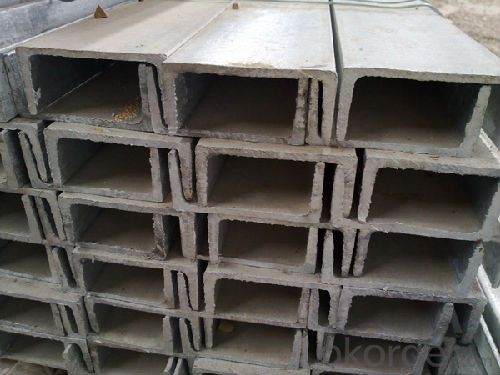
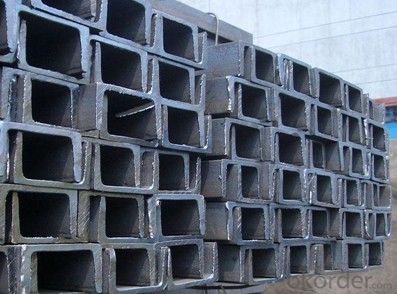
- Q: What are the different welding methods for steel channels?
- There are several different welding methods that can be used for steel channels, depending on the specific application and desired results. Some of the most common welding methods for steel channels include: 1. Shielded Metal Arc Welding (SMAW): Also known as stick welding, SMAW involves using an electrode coated in flux to create an arc between the electrode and the base metal. This method is versatile and can be used for both thick and thin steel channels, making it suitable for a wide range of applications. 2. Gas Metal Arc Welding (GMAW): Commonly referred to as MIG welding, GMAW uses a continuous wire electrode that is fed through a welding gun. The wire is melted and joined with the base metal while being shielded by a gas, typically a mixture of argon and carbon dioxide. This method is known for its speed and efficiency, making it ideal for high-volume production of steel channels. 3. Flux-Cored Arc Welding (FCAW): Similar to GMAW, FCAW utilizes a continuous wire electrode, but instead of using a shielding gas, it uses a flux-filled tubular wire. This flux creates a protective shield around the weld, eliminating the need for an external gas supply. FCAW is commonly used for outdoor applications or in environments with strong drafts that could blow away the shielding gas. 4. Gas Tungsten Arc Welding (GTAW): Also known as TIG welding, GTAW uses a non-consumable tungsten electrode to create an arc and heat the base metal. A separate filler rod is then manually fed into the weld pool, creating the joint. GTAW is known for its precision and control, making it suitable for welding thin steel channels or when a high-quality weld is required. 5. Submerged Arc Welding (SAW): SAW involves feeding a continuous wire electrode into the joint while a layer of granular flux covers the weld zone. The arc is submerged beneath the flux, providing a protective atmosphere and preventing the weld from being exposed to the surrounding air. This method is commonly used for thicker steel channels or when high deposition rates are required. It is important to consider the specific requirements of the steel channel and the intended application when selecting a welding method. Each method has its advantages and limitations, so it is crucial to choose the most appropriate method for achieving the desired results in terms of strength, aesthetics, and efficiency.
- Q: Can steel channels be used for supporting rooftop solar arrays?
- Indeed, rooftop solar arrays can be supported using steel channels. These channels, also referred to as steel C-channels or steel U-channels, are frequently utilized in construction due to their robustness and durability. When appropriately designed and installed, they can establish a stable and secure framework for mounting solar panels on rooftops. There are various advantages to utilizing steel channels for supporting rooftop solar arrays. Firstly, they possess a high load-bearing capacity, which is crucial for sustaining the weight of the solar panels and enduring external forces like wind and snow loads. This strength allows them to serve as a dependable and long-lasting support system for solar arrays. Secondly, steel channels can be effortlessly customized and fabricated to meet specific requirements. They can be cut into desired lengths and shapes, enabling flexible designs that accommodate different roof configurations and panel layouts. Additionally, steel channels can be galvanized or coated to provide corrosion resistance, thus ensuring the durability of the support structure. Moreover, steel channels are readily available and cost-effective. They are commonly employed in construction and can be easily obtained from steel suppliers. The cost of steel channels is relatively low compared to other support materials, making them a financially efficient choice for rooftop solar installations. To conclude, steel channels are a suitable option for supporting rooftop solar arrays due to their strength, versatility, and cost-effectiveness. However, it is vital to consult with a structural engineer or solar installer to ensure that the steel channels are appropriately designed and installed to meet the specific requirements of both the solar array and the building.
- Q: How do steel channels perform in high-temperature environments?
- Steel channels typically perform well in high-temperature environments due to their inherent strength and durability. The properties of steel, such as its high melting point and resistance to thermal expansion, make it suitable for use in elevated temperatures. Steel channels can withstand high temperatures without significant deformation or loss of structural integrity. One of the main reasons steel channels are effective in high-temperature environments is their ability to retain their mechanical properties at elevated temperatures. Steel has a high thermal conductivity, which allows it to effectively dissipate heat and prevent excessive temperature rise. This property helps to maintain the structural stability of steel channels even when exposed to high heat. Moreover, steel channels are often designed to have a high fire resistance rating. This is achieved by incorporating fire-resistant coatings or fireproofing materials to enhance their performance in extreme temperatures. These measures help to protect the steel channels from the detrimental effects of heat, including weakening or deformation. It is important to note that the performance of steel channels in high-temperature environments can be influenced by factors such as the specific grade of steel used and the duration of exposure to elevated temperatures. Different grades of steel have varying thermal properties, so it is crucial to select the appropriate grade based on the specific temperature requirements of the application. In summary, steel channels generally perform well in high-temperature environments. Their strength, durability, and ability to retain mechanical properties make them suitable for use in such conditions. However, it is recommended to consult with experts or refer to the manufacturer's specifications to ensure the steel channels are selected and utilized correctly for optimal performance in high-temperature environments.
- Q: The types of channel steels are 6, 8, 10, 12, 16, 20, 25, 32 and 14. What are their tensile strength of these types of channel steel?
- Sigma S shall be the yield strength and the ultimate tensile strength shall be sigma BThe yield strength of Q215 material is 215MPa, and tensile strength is about 335-410MPaThe yield strength of Q235 material is 235MPa, and tensile strength is about 375-460MPaThe yield strength of Q345 material is 345MPa, tensile strength is about 490-620MPa, thank you for adopting
- Q: Can steel channels be used in solar panel mounting structures?
- Yes, steel channels can be used in solar panel mounting structures. Steel channels provide a strong and durable framework that helps support and secure solar panels in place. Their versatility and ability to withstand various weather conditions make them a suitable choice for solar panel mounting systems.
- Q: What are the different weight classifications for steel channels?
- Steel channels are classified based on their weight per linear foot. The weight classifications for steel channels include lightweight, medium weight, and heavy weight. Lightweight steel channels typically have a weight per linear foot ranging from 1.0 to 6.0 pounds. These channels are commonly used in applications where strength is not the primary concern and where the load requirements are relatively lower, such as in decorative or non-structural applications. Medium weight steel channels have a weight per linear foot ranging from 6.1 to 16.0 pounds. These channels are often used in structural applications where moderate strength and load-bearing capacity are required, such as in building frames, supports, and bracing. Heavy weight steel channels have a weight per linear foot ranging from 16.1 to 40.0 pounds. These channels are designed to provide maximum strength and load-bearing capacity and are commonly used in heavy-duty structural applications such as industrial buildings, bridges, and infrastructure projects. It is important to note that the weight classifications for steel channels may vary depending on the specific standards and specifications set by different countries and organizations.
- Q: Can steel channels be used in food processing facilities?
- No, steel channels should not be used in food processing facilities as they can rust and contaminate the food. Stainless steel channels should be used instead, as they are corrosion-resistant and meet the hygiene requirements of such facilities.
- Q: How do steel channels contribute to ventilation in structures?
- Steel channels can contribute to ventilation in structures in several ways. Firstly, steel channels can be used as part of a ventilation system to direct and distribute airflow throughout a building. These channels can be strategically placed to ensure that fresh air is brought in and stale air is removed. Additionally, steel channels can be used to support ventilation equipment such as fans, blowers, and air conditioning units. By securely mounting these devices on the channels, they can effectively circulate and distribute air throughout the structure. Furthermore, steel channels can be utilized to create air ducts within the building. These ducts can be used to transport air from one area to another, ensuring that airflow is properly distributed and reaching all areas of the structure. By using steel channels for this purpose, the ducts can be strong, durable, and resistant to damage, ensuring long-lasting and efficient ventilation. Overall, steel channels play a crucial role in the ventilation of structures as they provide the necessary support for ventilation equipment, help direct and distribute airflow, and create durable air ducts. By utilizing steel channels in ventilation systems, structures can maintain optimal air quality, temperature, and circulation, thereby creating a comfortable and healthy environment for occupants.
- Q: Can steel channels be used in stadium construction?
- Steel channels are indeed suitable for stadium construction. These channels, which are also referred to as steel C-channels or U-channels, are widely utilized in the construction industry due to their robustness, durability, and versatility. In stadium construction specifically, they serve various purposes such as providing support for structural components, framing, creating architectural elements, and enhancing the overall strength of the structure. Steel channels play a crucial role in establishing seating areas, walkways, and staircases within stadiums. Moreover, they offer support for large screens, scoreboards, lighting fixtures, and other equipment essential for stadium operations. By incorporating steel channels into stadium construction, a solid and dependable structure is ensured, capable of enduring the immense loads and stresses typically experienced by stadiums.
- Q: How do steel channels contribute to sustainable design?
- There are several ways in which steel channels contribute to sustainable design. To begin with, steel channels are manufactured using recycled materials. Steel is widely recognized as one of the most recycled materials globally, with a substantial proportion of steel production coming from recycled scrap. This practice decreases the demand for raw materials and diminishes energy consumption during the manufacturing process, ultimately resulting in a reduced carbon footprint. Moreover, steel channels possess a remarkable lifespan. Due to its exceptional durability, steel can withstand harsh weather conditions and resist corrosion effectively. Consequently, steel channels necessitate minimal maintenance and replacement over time, thereby reducing the frequency of repairs and replacements. This not only conserves valuable resources but also minimizes the construction and demolition waste generated. In addition, steel channels are characterized by their lightweight nature and versatility. These qualities allow for efficient transportation and installation, which, in turn, decreases fuel consumption and associated emissions. Additionally, the versatility of steel channels enables them to be easily repurposed or reused in other projects, extending their lifespan and minimizing waste. Furthermore, steel channels provide design flexibility. The strength and structural integrity of steel enable the implementation of innovative and efficient designs, such as open floor plans and large spans. These designs maximize natural lighting and ventilation, reducing the reliance on artificial lighting, heating, and cooling systems. Consequently, energy consumption is lowered, and greenhouse gas emissions are reduced. Lastly, at the end of their lifespan, steel channels can be recycled. Steel is entirely recyclable, allowing it to be reused indefinitely without any loss of quality. This not only conserves natural resources but also reduces the amount of waste that ends up in landfills. In conclusion, steel channels significantly contribute to sustainable design through their utilization of recycled materials, long lifespan, lightweight and versatile nature, design flexibility, and recyclability. By incorporating these features, construction projects can minimize their environmental impact and promote the development of a more sustainable built environment.
Send your message to us
U CHANNEL GB and JIS standard High Quality Hot Rolled
- Loading Port:
- Tianjin
- Payment Terms:
- TT or LC
- Min Order Qty:
- 25 m.t.
- Supply Capability:
- 20000000 m.t./month
OKorder Service Pledge
OKorder Financial Service
Similar products
Hot products
Hot Searches
Related keywords
